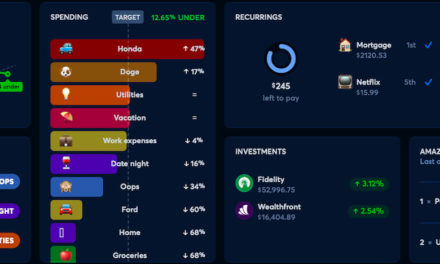Understanding your family finances plays a crucial role in managing your household’s financial well-being. This is known better as family financial management.
It involves tracking income, expenses, and savings to ensure your day-to-day financial stability while also meeting your short and long-term financial goals.
Creating and following a family budget is a fundamental step towards achieving financial security, though getting a complete picture of your family’s finances may be a bit harder than you think.
How to Improve Your Family Financial Management

Family financial management is the complete picture, it encompasses all aspects of managing money within your household.
It involves understanding and tracking income from various sources, such as salaries, investments, and even your side hustles.
Additionally, it includes monitoring and controlling expenses, such as bills, groceries, and discretionary spending.
Finally, in order to gain greater financial security, it also involves planning and setting aside savings for emergencies, future expenses, and long-term financial goals like education, retirement, or buying a house.
At the end of the day, the greater understanding you have over all your money, the better decisions you can make to achieve your financial goals.
These 5 tips will help you find the right financial planner for your family
Turning Family Expenses into Family Financial Managment
As your family grows, the more needs you have. That means it’s easier for money to go out the door without you really knowing it.
Costs are going up, which means it takes more just to maintain what many currently have.
With so much of our life on digital platforms, spending money is easier and less tangible. Meaning, it may not even “feel” like you’re spending as much money as you are.
Developing a monthly family budget allows you to see where your money is needed and the first step to managing your finances effectively. It helps allocate income to cover necessary expenses, save for the future, and avoid unnecessary debt.
Here are the key steps to building a monthly family budget:
- Determine Income and Expenses: Start by calculating your total monthly income (from all sources) and categorizing your expenses. Separate fixed expenses (rent, mortgage, utilities) from variable expenses (groceries, entertainment).
- Track and Analyze Spending: Monitor your spending habits over the course of three to five months to identify patterns and areas where you can cut back. Use budgeting apps (like my favorite one) or spreadsheets to track expenses easily.
- Set Financial Goals: Establish short-term and long-term financial goals. These can include saving for a vacation, creating an emergency fund, or paying off debts. Prioritize these goals based on their importance.
- Allocate Income: Assign a specific portion of your income to each expense category. Start with essential expenses like housing, utilities, and groceries. Then, distribute the remaining income towards savings and discretionary spending. Even if it’s a limited amount, you should always strive to set some money aside for savings.
- Review and Adjust: Regularly review your budget to ensure it aligns with your financial goals. Make adjustments as needed to accommodate changes in income, expenses, or financial priorities.
Four Approaches to a Family Budget
Let’s look at a few examples of how a family budget can be structured based on different financial situations:
The Balanced Budget: This budget allocates a similar percentage of income to each category, aiming for a balanced distribution of funds. It ensures that essential needs, savings, and discretionary expenses are all accounted for.
This can be an effective approach if you are a steady and even spender. You don’t have frequent big-ticket expenses and can consistently forecast what your income and expenses will be.
The Debt-Reduction Budget: If you have significant debt, such as credit card debt or student loans, this budget focuses on allocating more funds toward debt repayment. It aims to minimize interest payments and accelerate your journey toward financial freedom.
This approach takes much more financial and personal discipline. It’s tough to forego eating out, frequent fun activities or other discretionary spending. But when you choose to focus on reducing debt, that’s the necessary approach.
The Goal-Oriented Budget: This budget is designed to help you achieve specific financial goals. It involves allocating a significant portion of your income to savings and investments, allowing you to make progress towards milestones like buying a house or starting a business.
It’s important to understand not all financial goals have to be long-term big ticket items. Additionally, you can work to fund multiple goals at once. This budget allows for some discretionary spending but places a larger emphasis on saving for the future.
The 50/30/20 rule: This a simple budgeting guideline that suggests how to allocate your income across different categories:
- 50%: Allocate 50% of your income to needs. This includes essential expenses like housing, utilities, groceries, transportation, and insurance.
- 30%: Dedicate 30% of your income to wants. These are non-essential expenses, such as dining out, entertainment, hobbies, and discretionary spending.
- 20%: Save or invest 20% of your income for savings and financial goals. This category covers savings accounts, retirement funds, paying off debt, and building an emergency fund.
This budgeting app will be a game changer for tracking and budgeting your expenses
Family Budget Examples
Family finances look different for every person and every family. There is no one-size-fits-all formula but building your budget around key common categories can help quickly establish a plan for your financial future.
You don’t need to break out every expense into its own category but if you start by grouping like-expenses together and build a plan around your needs versus your wants you will be taking the first major step forward in building your wealth.
Remember that actual budgets vary, and it’s essential to tailor your budget to your unique circumstances and financial goals.
Example 1: Lower-Income Family Budget
| Category | Monthly Amount ($) |
|---|---|
| Total Monthly Income | $3,000 |
| Expenses | |
| Housing (Rent/Mortgage, Utilities) | $1,000 |
| Groceries | $300 |
| Transportation (Car Payment, Gas, Insurance) | $400 |
| Healthcare (Insurance, Co-pays) | $150 |
| Childcare/Education | $200 |
| Utilities (Electricity, Water, Internet) | $150 |
| Personal Care (Toiletries, Haircuts, etc.) | $50 |
| Entertainment | $50 |
| Savings | |
| Emergency Fund | $50 |
| Debt Payments | |
| Credit Cards, Loans | $500 |
| Total Expenses | $2,850 |
| Remaining for Savings/Debt Reduction | $150 |
Example 2: Middle-Income Family Budget
| Category | Monthly Amount ($) |
|---|---|
| Total Monthly Income | $6,000 |
| Expenses | |
| Housing (Mortgage, Utilities) | $1,500 |
| Groceries | $500 |
| Transportation (Car Payments, Gas, Insurance) | $600 |
| Healthcare (Insurance, Co-pays) | $300 |
| Childcare/Education | $400 |
| Utilities (Electricity, Water, Internet) | $200 |
| Personal Care (Toiletries, Haircuts, etc.) | $100 |
| Entertainment | $200 |
| Savings | |
| Emergency Fund, Retirement | $500 |
| Debt Payments | |
| Student Loans, Credit Cards | $400 |
| Total Expenses | $4,600 |
| Remaining for Savings/Debt Reduction | $1,400 |
Example 3: Higher-Income Family Budget
| Category | Monthly Amount ($) |
|---|---|
| Total Monthly Income | $10,000 |
| Expenses | |
| Housing (Mortgage, Utilities) | $2,000 |
| Groceries | $800 |
| Transportation (Car Payments, Gas, Insurance) | $700 |
| Healthcare (Insurance, Co-pays) | $500 |
| Childcare/Education | $600 |
| Utilities (Electricity, Water, Internet) | $300 |
| Personal Care (Toiletries, Haircuts, etc.) | $150 |
| Entertainment | $300 |
| Savings | |
| Emergency Fund, Retirement, College Fund | $2,000 |
| Debt Payments | |
| Student Loans, Mortgage | $1,000 |
| Total Expenses | $7,250 |
| Remaining for Savings/Debt Reduction | $2,750 |
Be Money Motivated for your Future
Implementing a family budget tailored to your financial situation, can effectively manage your family’s finances, achieve financial goals, and ensure a secure future.
Whether it’s saving for college, retirement, getting out of debt, a future home, new car or any number of other financial needs, having disciplined family financial management is a key component of success.
This is not a fast process. This is a plan, a goal, a journey. Set realistic expectations, have accountability and commit to making good financial decisions that will have a positive impact for your future.
Remember, consistently tracking expenses, reviewing your budget, and making necessary adjustments are key to maintaining financial stability.
Start your journey towards financial well-being today by creating a family budget and taking control of your family’s finances!
I am not a financial professional. The information in this post is for informational purposes only. I may receive compensation from advertisements when you click on links to those products on this page.













